


The steam fire engine on display in Carillon Park represents the third, and perhaps most colorful, phase of man’s long battle against fire. During the time of the bucket brigade, fire-fighting was carried on without the help of machinery. A great step forward occurred with development of hand-operated pumping machines in the early 18th Century. Later, the steam fire engine replaced human muscle in the operation of the pumps. The modern era of fire-fighting began with use of the internal combustion engine for both motive and pumping power.
Various photographs and drawings in this booklet were reproduced through the courtesy of the following: The H. V. Smith Museum of The Home Insurance Company granted permission to reproduce drawings and pictures appearing on Pages 3, 6, 7, 9, 11, 14 and 15; The Dayton Daily News, the Dayton Journal-Herald and the American-LaFrance-Foamite Corporation also contributed photographs.

The steam fire engine—like the Conestoga wagon, the Concord coach and the canal boat—has faded from the American scene. But as long as man thrills to the battle against fire, as long as he is intrigued by intricate machinery and stirred by bold actions, this wondrous vehicle is not likely to be forgotten.
This booklet summarizes the story of the steam fire engine—its birth amid derision, its growth in utility and popularity, its golden era of service and its final decline in the face of relentless technical progress.
Humor and pathos, heroics and rowdyism, brilliant inventiveness and indomitable Yankee spirit comprise the bright pattern of steam fire engine history. These gaudy machines are perhaps as symbolic of life in America during the latter half of the 19th Century as any other mechanical memento left behind by preceding generations.
England deserves the credit for invention of the steam fire engine, but to America goes the distinction of having perfected it. Nowhere was the steam fire engine more widely used than in the United States, with its preponderance of highly inflammable wooden buildings. Certainly nowhere else were the caretakers of the glittering engines so zealous in exhibiting their machines’ amazing qualities at every opportunity.
Most of those who knew and admired the steam fire engine during its heyday have departed, and few of the machines themselves have escaped the final oblivion of the scrap heap. Those engines that have been preserved, however, attest to the craftsmanship of their makers. In symmetry of design, sound construction and elegant finish they constitute a classic example of fine American manufacture.
The cities and hamlets of America will not witness again the drama of plunging horses speeding to a fire with a heavy, smoke-belching engine clattering behind; the piercing alarm of the steam fire whistle has been stilled. The era to which these things belonged lives now only in memory, pictures and words.
This booklet has been prepared to help recapture for present-day readers at least a segment of that vanished world.

Although fire is one of man’s most useful servants, it has also been one of his deadliest enemies. Most of the great cities of the world at one time or another have been totally destroyed or badly damaged by fire. The number of lives lost to flames down through history will never be known, but it has been of staggering proportions.
Early attempts in America at doing something about this constant peril consisted mainly of making the best of a bad situation, since technical knowledge was so limited that development of efficient fire-fighting machines was slow. Thus, in the first fire society, organized in 1718, members were charged with salvaging what they could when a neighbor’s house caught fire. Each man in the society carried a large bag, into which he stuffed the householder’s personal effects before they were consumed by the flames. Other equipment included a bed key with which to dismantle the family bed, usually the most valuable piece of furniture the colonist owned.
Benjamin Franklin’s broad genius was to make itself felt in the field of fire-fighting as in others. The inventor-statesman was a co-founder of the first fire-fighting company in Philadelphia, in 1736, and also co-founder of the first successful fire insurance company in the United States, in 1752.
The development of fire-fighting machines cannot be claimed exclusively by recent generations. As early as the reign of the Ptolemies in Egypt, some 200 years before the Christian era, a hand-pump fire engine was constructed which was similar to those later used in the 19th Century. This first known fire engine was described by the Greek writer Heron, who reported that the machine operated through a pump and air-chamber mechanism which forced water out of a spout by means of compressed air. As has frequently happened in the up-and-down course of history, the techniques involved in the manufacture of this early engine were lost.
Richard Newsham of London is generally credited with invention of the first successful fire engine of more recent times. One of his hand-pump machines, an early model in a long line of “musheens” (machines), was imported by the City of New York in 1731 and was the first fire engine to be used in that city. In 1743, the first successful American hand pumper was built by Thomas Lote. For the most part, however, fire-fighting in colonial America was accomplished largely through the centuries-old “bucket brigade.”
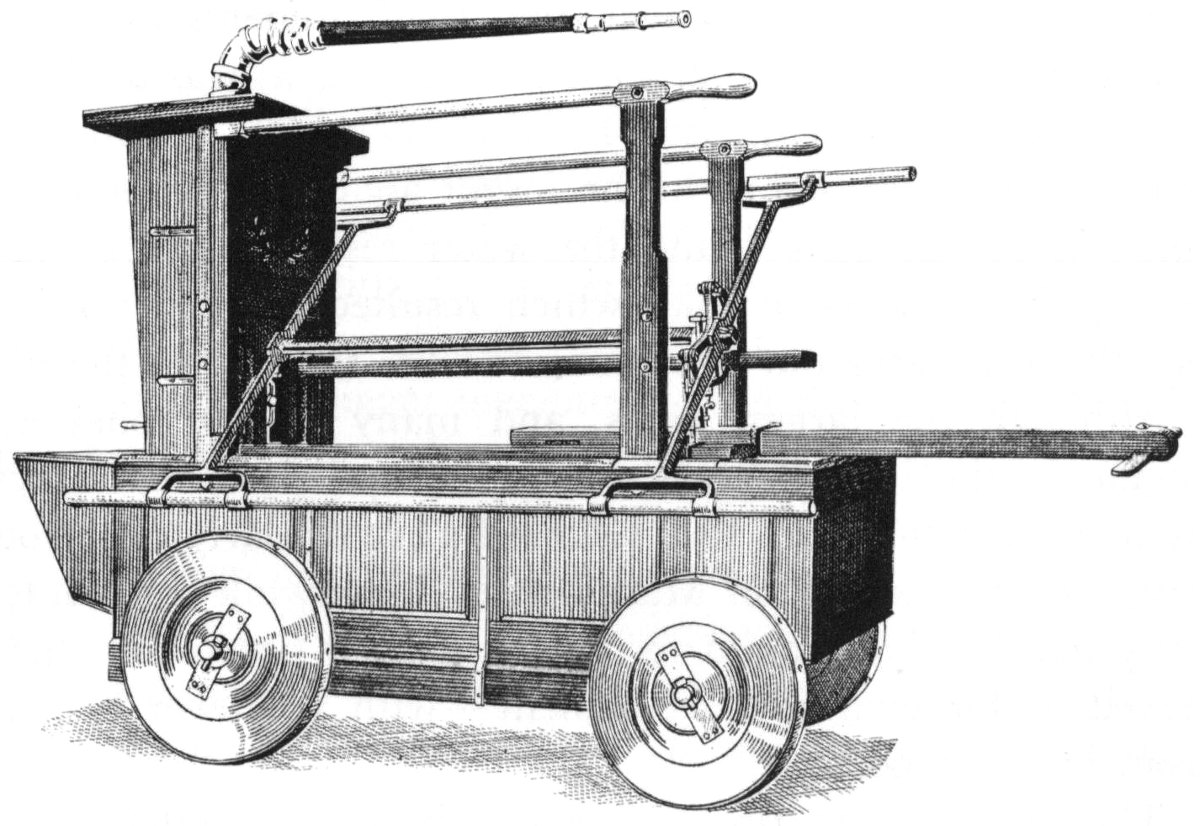
The first fire engine used in New York was this machine imported from London in 1731. Water was pumped from the “tub” at the bottom of the engine out through the “gooseneck” hose. Power was supplied by sturdy colonists who pumped the handles, called “brakes.” The engine’s water reservoir was filled with buckets.
The buckets, made of leather, were customarily hung at the front of houses. When an alarm was sounded, citizens racing to the fire would seize the nearest bucket available. Once on the scene of the blaze, they would locate a source of water and then form two lines between it and the fire. One line, usually composed of men, passed the full buckets from hand to hand. The other line, made up of women and children, would pass back the empty buckets for refilling. Anyone who attempted to break through these lines during the course of a fire was subject to a more complete dousing by the fire-fighters than was the blaze itself.
After the fire was extinguished—or when it had burned itself out—the buckets were placed in a central public location and messengers sent throughout the city shouting “Claim your buckets.” This seldom presented a problem, since most householders labeled their buckets by name, and some even emblazoned them with brilliant colors and family coats-of-arms.
As late as 1824 fire buckets were the sole means of combating flames in Dayton. The importance attached to their availability is indicated by an old ordinance which required each citizen to keep two buckets in an easily accessible place on his premises.
Many cities found, however, that their residents were not as dependable in the maintenance of their fire buckets as was desirable. One New Yorker, it is reported, used his fire bucket as a container for beans. Rushing to a fire one night, he forgot about the beans and emptied the contents of the bucket into the water reservoir of an old hand-pump fire engine. The bean soup which resulted clogged up the pump and put the apparatus out of commission for the rest of the night.
Although the largest cities, and many smaller ones also, had fire engines in the 18th Century, it was not until 1826 that Dayton acquired its first hand pumper. This followed a particularly disastrous fire which destroyed two stores on Main Street. Meanwhile a volunteer fire company had been organized to replace the old system in which every man served as his own fire department—with whatever help he could get from his neighbors.
The new Dayton fire engine was hardly a model of efficiency; yet compared with bucket-brigade methods it represented a big step forward. Typical of fire engines of that day, it contained a water reservoir and a pump which operated by means of a crank, water being forced through a leather hose at the fire or at least in its general direction. Fire buckets were still essential, however, since they were used to fill the pumper’s water reservoir.

The Dayton hand pumper shown in an old photograph above, Niagara No. 1, once held the United States record for the highest “throw” of water. On August 5, 1858, at the canal at Library Park it sent a one-inch stream of water through 600 feet of hose and 205 feet into the air. The engine, built in Rhode Island, was an “end-stroke” type. Its suction hose did away with the need to fill the reservoir with buckets, provided a water source was available.
In 1830 another small engine was purchased by Dayton for $300 and a second volunteer fire company of thirty-two men was organized. But the often-singed Daytonians apparently were still not satisfied with the protection offered. Acting on “a very large and respectable petition of the citizens for a good engine for the use of the town,” the Council authorized purchase of a bigger machine. Called the “Independent,” the new pumper had two sets of handles, called brakes, and was manned by twenty volunteers on each side. Pumping it was back-breaking work, necessitating “spelling” of the volunteers from time to time, but results were much improved. To house the Independent, the city erected a building at Third and Main Streets, which became headquarters for the new company of 100 volunteers which was formed to handle the engine.
It was about this time that reliance on nearby wells or the Miami-Erie Canal as sources of water was abandoned. Cisterns were built at First and Main, Third and Main and Fifth and Main for use of the fire-fighters. The first successful fire hydrant had been developed about 1820, but was not adopted in Dayton until many years later. From a wooden plug inserted to stop up the opening in the early hydrants, the term fireplug originated.

Shown above is a famous New York hand pumper, the “Old Maid.” One of the most powerful and ornate engines of its day, this “musheen” even had a keg for spirituous liquors attached to the tongue. When their water supply was distant, firemen often pumped water from one engine to the next. Rival companies then tried to “wash” the engine ahead by overflowing its reservoir. A “washed” engine was said to be no longer a maiden. The “Old Maid” received its unusual name because for a long time no rival engine managed to “wash” it.
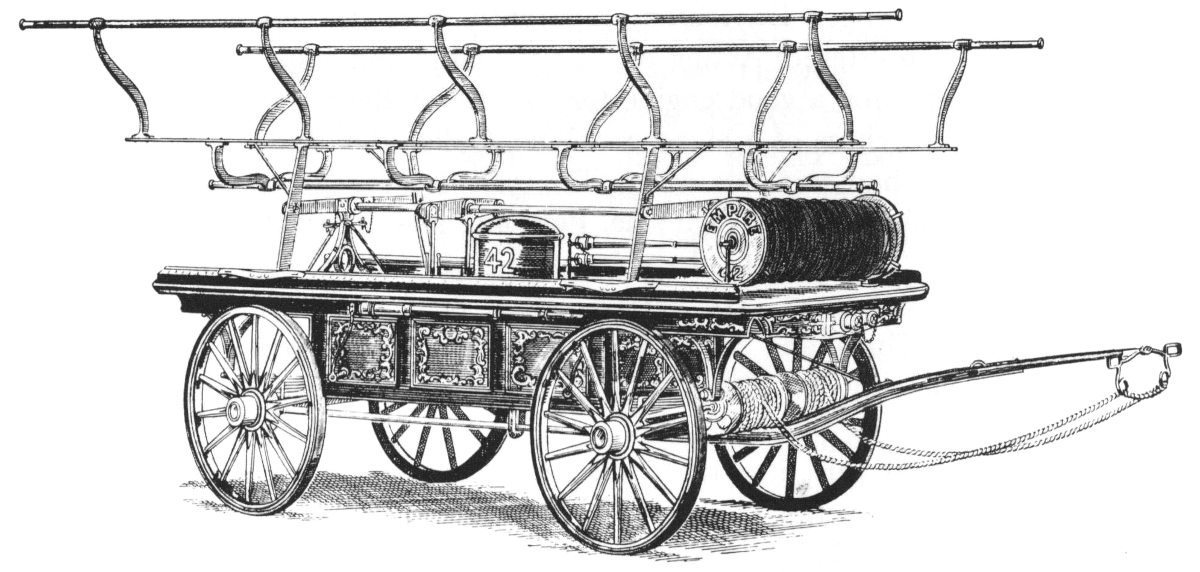
Called “Mankiller” because it was difficult to pump, this engine was one of the most powerful hand-operated machines ever built. It reportedly could throw a stream of water higher and farther than many steam fire engines built years later. This type of hand pumper was known as a “haywagon” because of its rack-like brakes.
In 1835 the Dayton City Council agreed to pay “fifty cents to each of the sextons of the several churches, as well as to the sheriff, for ringing their respective bells at each fire to give the alarm more generally to the citizens.” It was not until ten years later, in Boston, that the first telegraphic fire alarm was developed. The new system employed fire-alarm boxes, similar to those in use today, which sent the alarm to a central point, from which alarm bells were struck electrically, replacing the old church bell method.
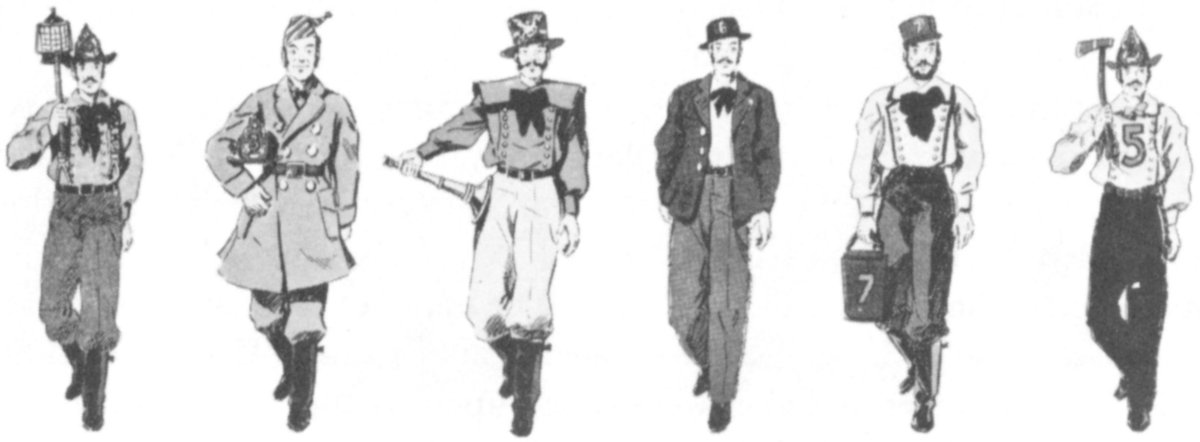
Old-time volunteer firemen often wore flamboyant uniforms, although their habitual attire at fires was the clothing they happened to be wearing when the alarm sounded. The “vamps” bought their own uniforms and took great pride in the appearance of their companies at such public events as parades.
Between 1830 and 1850, hand pumpers were being improved in many ways. The old “tub” engines with water reservoirs which had to be filled with buckets eventually gave way to suction pumpers. These machines still employed a water reservoir but the tank was filled—provided a dependable water source was available—through a heavy hose which drew water into the engine. Unfortunately, a good water supply was not always close at hand. When the water supply was distant, the engines would be formed in line and water pumped from one engine to the reservoir of the next. At one New York fire, more than thirty engines were lined up for a mile and a half in order to produce a single small stream of water.
When operating in a line, the companies usually engaged in one of their most popular contests—that of trying to “wash” the engine ahead of them. An engine was said to be washed when its reservoir was filled to overflowing by the superior pumping power of the engine behind. To allow this to happen was considered a great disgrace. Handicapped by an inefficient engine, men in danger of being washed would often speed up their pumping to the rate of 120 strokes a minute, a pace that could be maintained for only a few minutes even by the most rugged. 8 When thoroughly fatigued, a volunteer would drop off the pump handles and another man would rush in to take his place. During high operating speeds, this could be dangerous, with cuts, broken fingers and fractured arms resulting.
An unfortunate counterpart of the technical gains achieved in fire-fighting during the hand-pump period was the sharp increase in rivalry among different volunteer companies. In many cases this spirit of competition spilled over into acts of violence.
Not content to use fair means of reaching a fire first, some rival volunteer companies put obstructions in front of their competitors’ engines, chopped hose to ribbons and broke into fisticuffs at every opportunity; one famous battle in Manhattan lasted for several hours. Many companies found the sidewalks smoother than the streets; whenever possible they pulled their engines at full speed down the sidewalk, scattering hapless pedestrians aside like ten pin’s. The spirit of the day was “Go as you please” and “Hit a head wherever you see one.” If fists wouldn’t do the job, wrenches and axes were called upon. If they were insufficient, even firearms were sometimes employed.
Such behaviour was not confined only to the largest cities. Dayton historian Charlotte Reeve Conover reported that “Sometime during the fifties the [fire] companies changed in personnel. The solid citizens took to lying abed and letting the boys about town fight fires, with the result that demoralization set in which put an end to the volunteer system. It was competition which ruined them.”
She adds, “It will not be found surprising that in time there came to be something that Daytonians dreaded worse than a fire, and that was the Fire Department.”
The extent of the inter-company rivalry was dramatized by a memorable street battle which occurred in 1856 in Dayton. While fire was destroying a carpentry shop, the “Vigilance” and the “Deluge” fire companies began arguing over which should take the more advantageous position for battling the flames. Eventually the fire was forgotten as the volunteers engaged in a free-for-all. One fireman during the course of the fight was mortally injured when hit on the head with a brick. This incident was only one of several which led to the disbandment of Dayton’s volunteer fire companies in 1863 and the setting up of a regular paid fire department.
It was during the pre-Civil War period of strife, and only forty miles southwest of Dayton, that an unknown mechanical genius named Moses Latta was perfecting the steam fire engine. Although the Cincinnatian’s 9 development would one day make the old hand pumpers as obsolete as the fire buckets which preceded them, it would still be some time yet before the full significance of his work was realized.

Intense rivalry among volunteer companies in the era of the hand pumpers frequently resulted in street fights. One battle began when two companies argued over use of a fire hydrant. The so-called hydrant later turned out to be only a half-buried cannon used as a hitching post.
Moses Latta was not the first man to harness steam as a replacement for muscles in fire-fighting. The earliest steam fire engine had been fashioned in 1829 in London by George Braithwaite, a noted engineer. His assistant on the project was John Ericsson, who more than three decades later was to win recognition in this country as the designer of the ironclad “Monitor” of Civil War fame. Appropriately dubbed the “Novelty,” Braithwaite’s steam fire engine never captured the public’s fancy, although a few were sold on the Continent, one purchaser being the King of Prussia. In 1833 Braithwaite gave up his project.
The idea would not die quite so easily, however. In 1840 another English engineer, Paul Hodge, built a steam fire engine for several New York insurance companies which were finding the fire-fighting inefficiency of that day extremely costly.
Hodge’s engine never had a fair chance. For a long time not a single volunteer company in New York would undertake to man the cumbersome machine, fearing it would replace the volunteers’ beloved hand-pump engines and spoil what had become their favorite pastime—fighting fires in the rough and tumble old-fashioned way. After a little pressure, however, one fire company agreed to operate the machine, and a trial period of several months followed. Almost immediately, the firemen began grumbling about the engine’s awkwardness. They also claimed it didn’t produce enough steam. The constant derision that had greeted their innovation finally discouraged the sponsoring insurance companies. Concluding that the loss in the volunteers’ morale more than outweighed any advantages offered by steam, they dropped their short-lived crusade, and sold Hodge’s engine to a manufacturing firm. There it served the remainder of its days in the unglamorous role of a stationary engine.
The same John Ericsson who in 1829 worked with George Braithwaite on the world’s first steam fire engine, designed one of his own in 1841. But even though the engine looked good on paper, it was never actually built. The old aversion to progress by firemen of the day was responsible.
Not only New York but other cities as well were guilty of similar heel-dragging. In 1851, a Philadelphian named William Lay came up with another engine design. But again, antipathy, on the part of firemen prevented the engine from ever emerging beyond the drawing board. Fearful—and rightly so—that the advent of steam would spoil their “sport” and excitement, the firemen would not budge.
Such was the setting when, in 1852, Moses Latta of Cincinnati developed his first steam fire engine. This earliest Latta engine was only an experimental model, but it was good enough to prompt the Cincinnati city fathers in 1853 to loosen their municipal purse strings to the extent of $5,000 for construction of the world’s first successful steam fire engine, the “Uncle Joe Ross.”
A colorful account of Latta and his engine appears in William T. King’s “The American Steam Fire Engine.” Describing Latta in his workshop, King wrote:
“It was a long, high room, the walls on the east side being hung with drawings of the engine. Beneath the drawings ran a long workbench, and at this stood a man; a very diminutive specimen of humanity, short and spare, stoop-shouldered, even to deformity.
“He had a square, white-paper hat on his head, and was busy measuring something. While looking at him, the stranger saw that his head 11 redeemed his poor body; for it was massive, and the eyes had in them the light of genius....”

One of the most noted of the early steamers was “Manhattan No. 8.” In 1863 it was shipped from New York to London with a crew of men to compete in an international water-throwing contest.
After explaining the wonders of his invention, Latta is said to have told a visitor: “The trouble is that there is no certainty that this, or any other steam fire engine, will ever be allowed to work at a fire. You are probably not aware how bitter is the feeling of the volunteer firemen against this engine. They say it shall never throw a stream of water on a fire in this city; and I sometimes fear that I shall never live to see this grand idea brought into the service of the world. The recent riots here show what a mob can do in our city. My steps are dogged. Spies are continually on my track ... threatening me with all sorts of ills and evils unless I drop work on this engine and pronounce it a failure.
“I’ll never give up! I’ll build it, and there are enough men in this city to see that it has a fair trial; and it shall have it. When it is finished, it will be heard from at the first fire, and woe to those who stand in its way.”
As the date of the trial approached, the Cincinnati firemen were in ferment. It would never do to destroy the engine before the trial, they reasoned. On the other hand, if the trial proved successful, it would be equally risky to destroy the engine then. Consequently, a plan was formulated: make no demonstration of any kind at the trial, but—if the 12 engine was a success—wait for its first appearance at the scene of a real blaze. Then wreck the engine and render equally useless anyone who contributed to its operation.

In this photograph taken in 1909, a steamer is pulled past old Steele High School. The occasion was a parade which honored the Wright brothers.
The trial was a great success, exceeding even Latta’s highest hopes, and now the whole city waited for the first fire on which the “Uncle Joe Ross” would be used. They did not have to wait long. A few nights after the trial, a large warehouse broke into flames in the middle of the night. Historian King describes what followed:
“Down came the great steam fire engine, four mammoth gray horses in front of it at a gallop; the smoke streaming from its stack, the fire flashing from its grates. Its ponderous wheels ground the cobblestones into powder as they struck them; and as the great monster went down the hill, people woke as out of a trance and started after it ... the time had come.”
The engine had just started to “play” water on the flames when a cry rang out: “The hose is cut.” The volunteer firemen had taken the first step in carrying out their plan.
Then occurred one of the most critical of all the melees that characterized fire-fighting of that time—a pitched battle between ordinary citizens and the irate volunteer firemen. Fortunately for the engine, for Latta and for the public in general, the citizens proved the stronger. Thoroughly whipped, the firemen gave up the struggle and the big steamer soon had drowned out the fire.
The next day Latta found himself the hero of Cincinnati. Although few were aware of it at the time, the era of the steam fire engine had finally arrived.
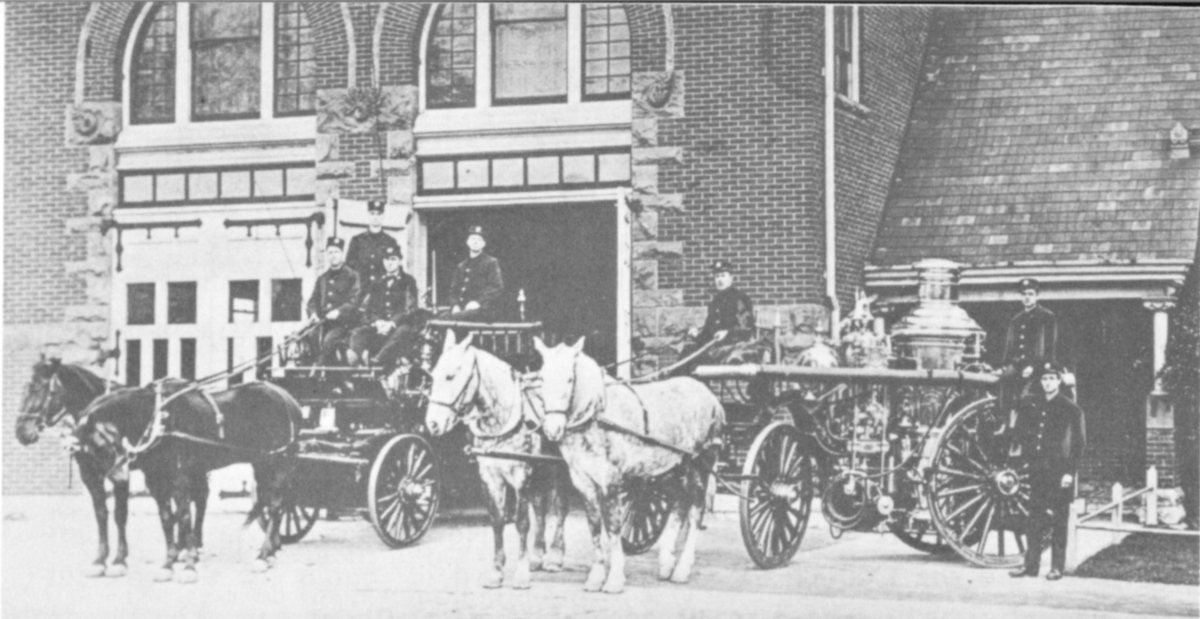
This view of the Dayton firehouse at Main and Monument shows a steamer and a ladder wagon, with their crews. The year is 1910.
The advent of steam in the age-old field of fire-fighting soon swept aside most of the old hand-operated engines. It also cleared away many of the impediments to fire-fighting efficiency inherent in the old volunteer system. Operating a steam fire engine required something more than sheer brute power and the ability to “knock in” sundry heads.
Thus it was not coincidence that saw most volunteer fire companies being replaced by professional fire fighters about the same time hand pumpers were succeeded by steamers. Cincinnati had pioneered the first successful steam fire engine, and it was Cincinnati that established the first paid fire department in 1853—the same year that marked the triumph of Moses Latta’s ponderous “Uncle Joe Ross.” The Queen City was also the first to have an all-steam fire department.
Dayton followed her neighbor’s example a decade later when three steamers were purchased following the burning of the old Dayton Journal by a mob incensed over Civil War issues. This famous blaze proved to be the last stand of the old volunteers and also the final time that hand pumpers were operated in Dayton without the assistance of steam fire engines.
Early in 1864 the Dayton City Council resolved that “an appropriation be made in favor of fire department for the sum of $300, payable 14 to the chief of said department for the payment of employed men, purchase of feed, etc.” It was also decided that “compensation of engineers of steam fire engines shall be $50 per month and the firemen, drivers and pipemen shall be $36 per month until further ordered by Council.”
At the same time a paid fire department was established in Dayton, the Council summarily disbanded all the volunteer organizations as of March 1, 1864. The reputation of the volunteers at the time of disbandment must have been at an all-time low. Nowhere in its various resolutions did the Council extend a single word of thanks for the colorful vamps’ (volunteers’) four decades of service without pay. The rowdy behavior of the old-time volunteers is in sharp contrast to the efficient community service performed by today’s volunteer firemen.

Fire marks, which were usually metal plaques, first appeared in the 17th Century. They were issued by insurance companies which maintained their own fire brigades. If a burning house bore the fire mark of a company, that company’s fire-fighters would lend assistance. If not, they customarily refused to help. After fire-fighting became a community effort, however, fire marks were simply a form of advertising. Shown above are the fire marks of three Dayton insurance companies. The Cooper mark was issued in 1867.
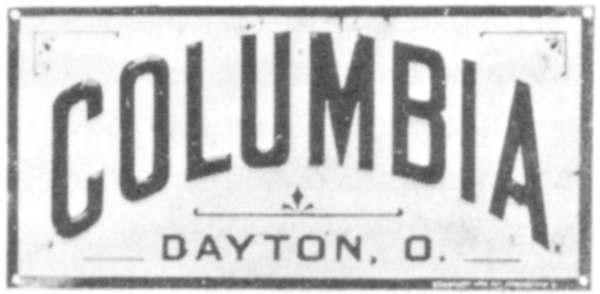
The Columbia mark’s issuance date is unknown.
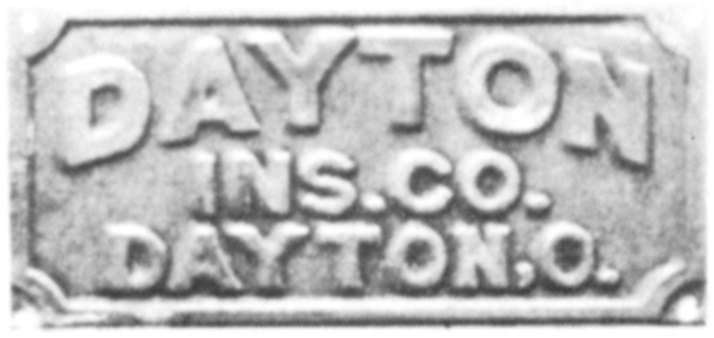
The Dayton Insurance Company mark was issued in 1851.
By now, conversion to steam was taking place throughout the United States. The steam fire engine, often called a “bulljine,” could run for hours without tiring. It made its debut in cities large and small, and firehouses began to assume some of the aspects of livery barns, since the steamers were usually too heavy to be pulled by men. Hay and oats soon came to be as much a part of fire department supplies as hose and axes, although just as firemen had opposed steamers as an insult to their strength, so they opposed at first the use of horses to pull equipment 15 to the fires. In some cases horses were obtained, after an alarm was sounded, at nearby livery barns, but the delay inherent in this procedure proved prohibitive.
As the trend to steam fire engines grew to landslide proportions, manufacturers of the new machines mushroomed all over the eastern United States. Almost every heavy machine shop which had had any experience with steam brought out an engine. Some erstwhile manufacturers never built more than one machine; others produced hundreds. Moses Latta, the pioneer in the field, enjoyed only a few brief years with minor competition, eventually selling his business.
The city or town which wanted to replace its old hand-pump engines and modernize its fire-fighting facilities had a wide choice in steam fire engines. If funds were low and the needs modest, an engine could be purchased for as little as $800. One such economy engine, built by the Knowles Steam Pump Works at Warren, Massachusetts, was as plain and homely as it could be; it offered no shiny plating or fancy striping, but it put out fires just the same.
At the other extreme were such monsters as those turned out by the Manchester Locomotive Works at Manchester, New Hampshire. One of this firm’s machines, the “Extra First Size,” towered more than ten feet and was almost twenty-five feet long. It weighed four and a half tons minus water, and was guaranteed to deliver at least 1,100 gallons a minute.
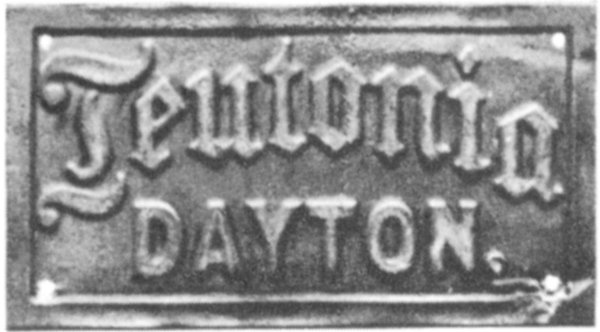
The fire mark of Dayton’s Teutonia Insurance Company, shown above, first appeared about 1870.
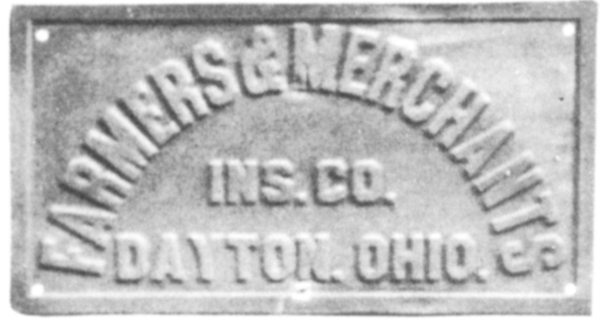
The mark of the Farmers & Merchants Insurance Company of Dayton was taken from a building on First Street. It was issued about 1865.

This unusual action picture shows a typical three-horse team used for pulling heavier steamers. Firehorses were carefully trained.
Training fire horses to pull the heavy engines was a long and complicated task. The setting off of the fire gong, which often automatically opened the stable doors, was the signal for the horse to take his proper place without guidance under the swinging harness which hung from the rafters of the engine house. This was of vital importance; a wrong or clumsy move would entangle the delicately arranged harness, delaying the run to the fire.
Running at full speed over rough and often poorly lighted streets with a several-ton engine rolling behind required perfect coordination with the other horse or horses in the team. Animals were often badly injured in falls and had to be destroyed. Like race horses, fire horses had to be kept in top condition.
The confining life of the fireman and his constant proximity to and dependence on the horses resulted in close relationships between the men and animals. When a horse grew too old for the demanding fire department life, his departure from the firehouse for a less arduous job, such as pulling a delivery wagon, was usually a touching occasion and a trying one, too, since it meant another long breaking-in process for his successor. It is no myth that former firehorses seldom forgot their original training. Stories are still heard of how the owners of former fire horses were dragged unwillingly to fires in their buggies and delivery wagons by horses which heard the alarm and immediately responded to their old training. Many fire horses could actually tell by the first digit of the alarm whether the fire would be a run for their own company, and most soon came to realize that a burning building was always their destination.
All over America, in cities large and small, the exciting spectacle of the steam fire engine rumbling to the scene of a blaze became commonplace, but never so commonplace that it failed to thrill both young and old. The interest in steam fire engines, which was kindled by various water-throwing contests, spurred additional competition, which in turn increased interest in the steamers still further.
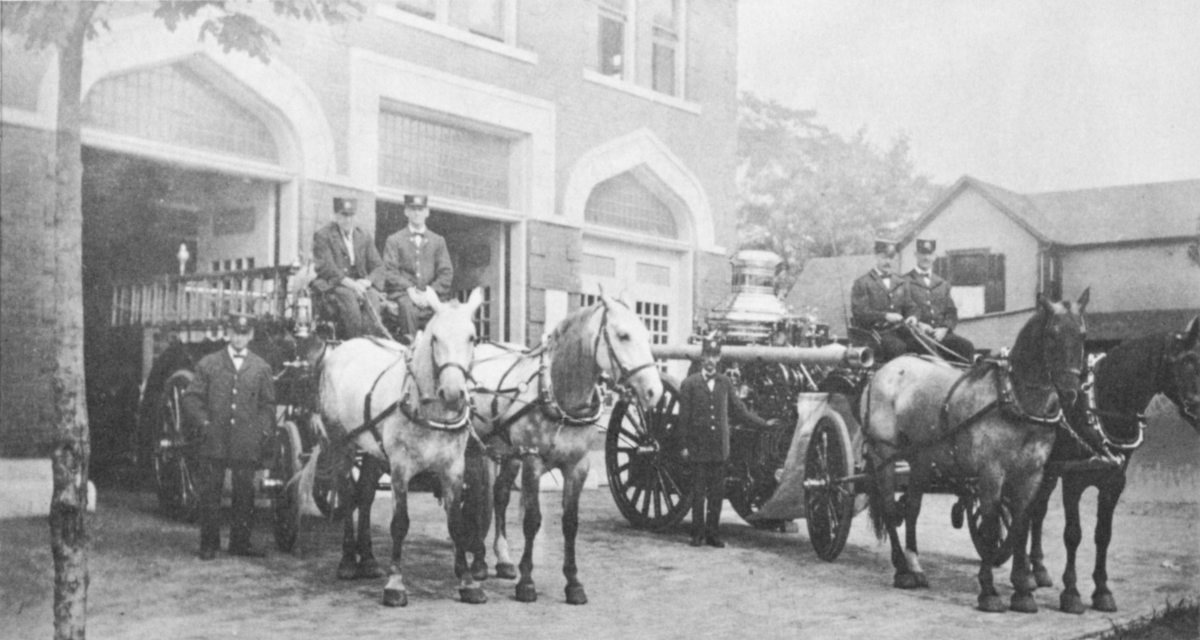
Like the caretakers of the old hand pumpers, firemen who operated “bulljines” usually kept their equipment in immaculate condition. The steamer shown below has been fitted with a tarpaulin behind the front wheels to keep mud off the engine.
As had been the case in the era of the old hand pumpers, different companies vied for honors in decorative skill also. Ornate and costly scrollwork and platings appeared on the engines with increasing frequency. Terse mottoes which set forth the firemen’s creed, such as “We Do Save,” were beautifully lettered on the engines. Many a latter-day fire captain climbed his first rung to higher rank by proving to be a capable man with the brass polish in his days as a rookie fireman. The phrase, “All dressed up like a fire engine,” had its origin in the loving care given the steamers and the old “musheens” which preceded them.

Residents of Detroit lined downtown streets on April 10, 1922, to witness the last run of this steam fire engine. Matched horses of high quality were not unusual during the heyday of the steamers.
Along with pay for firemen also came a more professional stature. The engineer of a steam fire engine in a well-respected company was a man of some standing, especially among the younger set. The American’s traditional love for machinery and for gadgets to make his work simpler found one of its most potent outlets in these glittering machines. A locomotive, its valve gear flashing as the engineer thundered past a Middle 19 West whistle stop, was a stirring sight at any time, but it could hardly compare with the glamor inherent in the old fire engine. Here were all the wonders of steam with the added dramatic ingredients of danger and the fight against man’s eternal enemy, fire. It is not surprising that “running with the engine” became as popular a sport as the church socials or Saturday night band concerts that characterized America in the late 19th Century.
During the heyday of the steamers, progress in fire-fighting was being made in other directions also. The first aerial ladder truck was perfected in 1870 and became popular following the famous Chicago fire of 1871. The aerial ladders were often called “big sticks,” and at first were raised by manual power. The water tower, which placed a powerful stream forty-five to sixty feet in the air, developed from a “hose elevator” constructed before the great Chicago fire and had a platform which could be raised or lowered. The water tower eventually became one of the fire-fighter’s most potent weapons.
The sprinkler system was introduced in 1874, and an automatic alarm device used in conjunction with sprinklers has proved to be one of the most effective fire-fighting aids ever devised. The same year, Rochester, New York, became the first city to install a high pressure water system, which delivered water at fireplugs under such great pressure that pumpers were not required, but the high cost resulted in a delay of twenty-five years until other cities began adopting similar systems.
Although the steam fire engine brought great gains in fire-fighting efficiency and ended many of the evils inherent in the old volunteer system, it was not a panacea for all the fire-fighting problems of the time. In most cities, politicians recognized a good thing when they saw it, and were quick to take an interest in the newly created paid departments. One historian wrote that Dayton’s paid fire department from 1864 to 1880 was under the “mismanagement of council” and largely subject to “the caprice, partisan aims and hunger of the politicians.”
But in 1880, disgusted with the estate to which the department had fallen, the citizens of Dayton obtained passage in the Legislature of a bill which created a non-partisan board of fire commissioners. The board immediately appointed Daniel C. Larkin as fire chief, and with this appointment the more modern era in Dayton fire-fighting history began. The department was reorganized after adoption of the commission-manager form of government in 1913, and has continued at a high level of efficiency.

The above diagram shows how the Carillon Park engine operates. Heat from the firebox (A) converts the water in the boiler (B) to steam. The steam enters the cylinder (C), causing the piston to move up and down. This motion is transmitted to the piston of the water pump (D), which draws water up through the suction hose and pumps it in the direction of the arrows. The air chamber (E) maintains constant pressure on the water, causing it to be fed to the nozzle smoothly instead of in spurts.
The demise of the steam fire engine was not an overnight occurrence. Most of the time-tested machines survived well into the 20th Century, despite the coming of the automobile and the accompanying mechanization of most forms of transportation.
At first, in the early 1900’s, gasoline tractors were attached to many of the steamers, retiring the luckier fire horses to pasture and the others to a more strenuous life. As gasoline engines increased in reliability, however, the next logical step was to use the gasoline power plant to run the pumps as well as to pull the vehicle. By the advent of World War I, most large cities had partially converted their fire-fighting equipment to gasoline, and by the mid-twenties the steamers were making their last stand, even in the smaller towns.
Just as the old “vamps” had opposed the steamers as replacements for hand pumpers, so opposition developed when the steamers were in turn replaced by gasoline equipment. Many firemen, willing to concede that the automobile was here to stay, were not so sure about the gasoline-powered 21 fire truck. A few diehards took a dim view about the internal-combustion engine in general. Cries of “undependable” and “cantankerous” were hurled in answer to talk about substituting gasoline power for the faithful fire horses. Such sentimental objections were a strong factor in postponing the death of the steamers.

Combination steam-gasoline fire engines bridged the gap between old-time steamers and present-day equipment. This Dayton engine depended upon an internal combustion engine for motive power, but used steam to drive its pumps.
There was one big advantage to gasoline mechanization, however, that could not be shouted down. Dependable as they were, the fire horses cost money. A few gallons of fuel, it became apparent, were much cheaper than the constant drain on the supply of hay and oats needed for the horses. According to one estimate, the savings each year after a gasoline tractor replaced the hungry horses that formerly pulled the steamer amounted to almost $1,000.
When these economic facts finally became apparent, it was obvious to most fire departments that all of the sentimental considerations in the world could not arrest the decline of the old steamers. More and more cities, including Dayton in 1916, joined the parade to gasoline.
At first, most of the cities replacing their steamers kept some of the old machines in reserve, but after several years they were usually consigned to the scrap heap, so that today only a tiny fraction of the machines once in use are still intact. Although they date back much farther, more of the hand pumpers perhaps have been preserved than their successors. In many older towns throughout the United States the old “musheens” are still operated at firemen’s festivals and other civic events similar to the old-time firemen’s musters.
Although gone forever, the steamers are far from forgotten. To many, modern-day fire-fighting equipment pales in comparison. Like the Clipper Ship, the steam fire engine seems likely to endure as one of the most colorful legacies in our great American heritage.
The steam fire engine on display at Carillon Park has been preserved through the efforts of the Sidney and Dayton Fire Departments. Originally the property of the Sidney Fire Department, it was donated to the Dayton Fire Department in 1953 for reconditioning and subsequent display. The refurbished engine, in like-new condition, was moved to Carillon Park concurrently with the opening of the park’s 1955 season. Educational and Musical Arts, Inc., the non-profit civic organization which operates Carillon Park, provided the structure which houses both the engine and the old-time fire bell which once hung in the fire station at Fifth and Brown Streets.
The fire engine is a single-pump Ahrens-Fox and originally cost $4,000. It was purchased by the City of Sidney in 1883 and remained in active service until 1916. From that time until 1928 it was kept in reserve. After 1928, the engine remained in storage until its restoration to original condition. The City of Dayton at one time employed a number of similar Ahrens engines, but of larger size. None of these machines could be located for restoration, however.
Named for Henry Young, the chief of the Sidney Fire Department at the time of its purchase, the engine was drawn by a team of pure black horses throughout much of its period of use. In addition to the steamer, the Sidney Fire Department had a ladder wagon, a hose wagon and a number of hose reels. Although this equipment seems scant as well as out-moded by present-day standards, Sidney in the latter 19th Century was listed as one of the better-equipped cities for fire-fighting in the United States in relation to its size.
Besides participating in many major fires at Sidney during its thirty-three years of active service and twelve years in reserve, the Henry Young was used several times to combat out-of-town blazes. At two of these fires, in Quincy and Piqua, the Henry Young was rushed by railroad flatcar to the scene after the fires had passed beyond control of the local departments.

The Carillon Park engine is shown above during its period of active service. Sidney firemen pose in the foreground.
During its long span of service, the Henry Young compiled an admirable record of dependability. In operation, the engine was first fired with wood which in turn ignited coal. Usually by the time the engine arrived at a blaze it had already developed a head of steam and was ready for use. As with most steamers, constant attention to the flues was required if the engine was to operate at peak efficiency.

The earliest aerial ladders were made of wood and mounted on horse-drawn trucks, with ladders being raised or lowered by hand-operated cranks. Today’s aerial ladder truck, as shown above, embodies tremendous improvements in safety and efficiency.
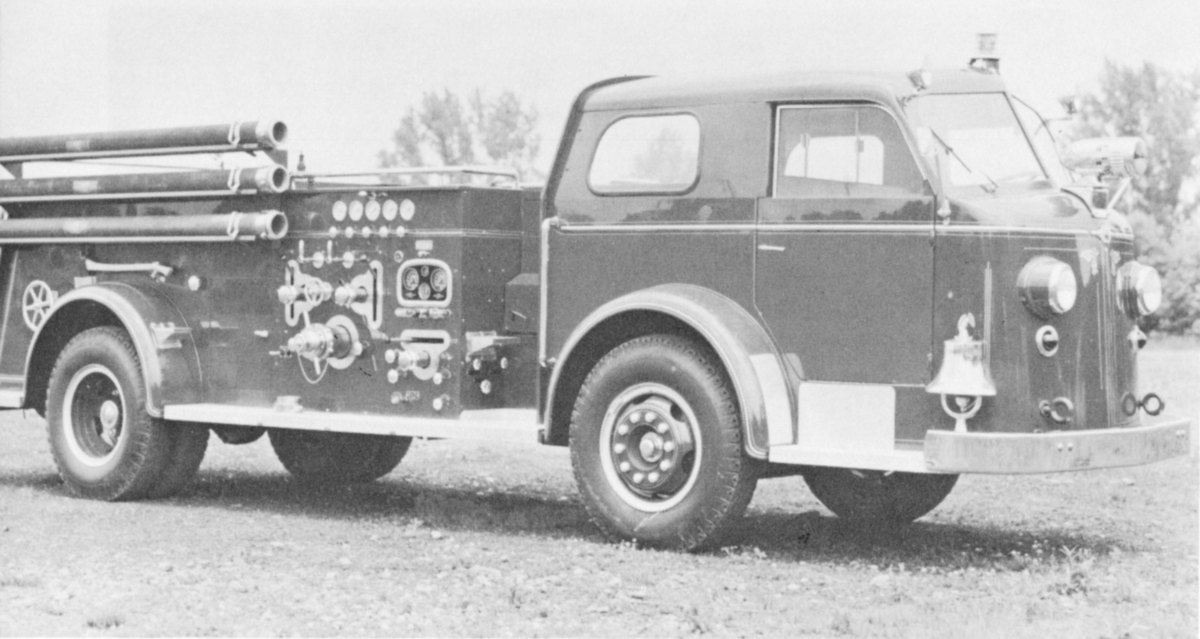
The modern pumper pictured above has an output of 1,500 gallons of water per minute, more than four times the pumping capacity of the Carillon Park steam fire engine. In addition, it carries 1,600 feet of hose.
A 275-horsepower motor provides instant and dependable power.
Another problem recalled by old-time residents of Sidney was the shower of sparks emitted when the engine was in use. Its operators were subjected to this fiery barrage at frequent intervals, with the result that coats and other items of clothing were often perforated by the red-hot cinders.
An anecdote which has survived along with the Henry Young concerns one hectic fire run during which the engine was almost wrecked. With the horses plunging ahead at full speed and the engine rounding a turn, one of its wheels hit a severe bump. For several long seconds, the engine careened wildly on two wheels. The thoroughly frightened driver sat paralyzed, even after the engine had righted, but the veteran fire horses headed unerringly toward the scene of the blaze. Proof that the horses really did find the fire, old-timers say, is that the driver was still immobilized at the end of the run, and had to be helped from his seat.
The Ahrens Manufacturing Company of Cincinnati, which built the Henry Young, was at one time the largest producer of steam fire engines in the Midwest. The ancestry of the Ahrens engines can be traced all the way back to Moses Latta, who accomplished what the world’s mechanical geniuses had hitherto failed to do by devising a boiler which not only generated a lot of steam but in addition produced the steam quickly. Once this milestone had been passed, the road to widespread and successful usage of steam fire engines broadened, and progress became correspondingly rapid.
The Ahrens firm had its start in 1868, having succeeded Lane & Bodley, the company that had bought Latta’s works. Ahrens was quick to make significant improvements. Whereas Lane & Bodley had built only seven or eight machines, depending on Latta’s patterns, Ahrens immediately introduced new designs which greatly increased the efficiency of the engines.
Ahrens engines were made in several sizes. The larger models had two cylinders and two pumps and were known as “double” engines. The smaller types had a single cylinder and a single pump. The Henry Young is a single-pump Ahrens, Size No. 2. Its steam cylinder has a diameter of nine inches and a stroke of nine inches; its pump cylinder has a five-and-a-half-inch bore and a nine-inch stroke. The engine weighs 5,800 pounds and can pump 350 gallons of water a minute.

The fire bell is shown when it served as a decoration at the Main and Monument firehouse.
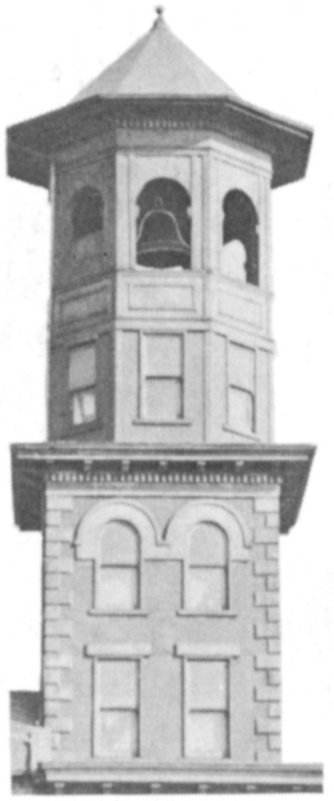
The tower of the old firehouse at Fifth and Brown where the bell was first used.
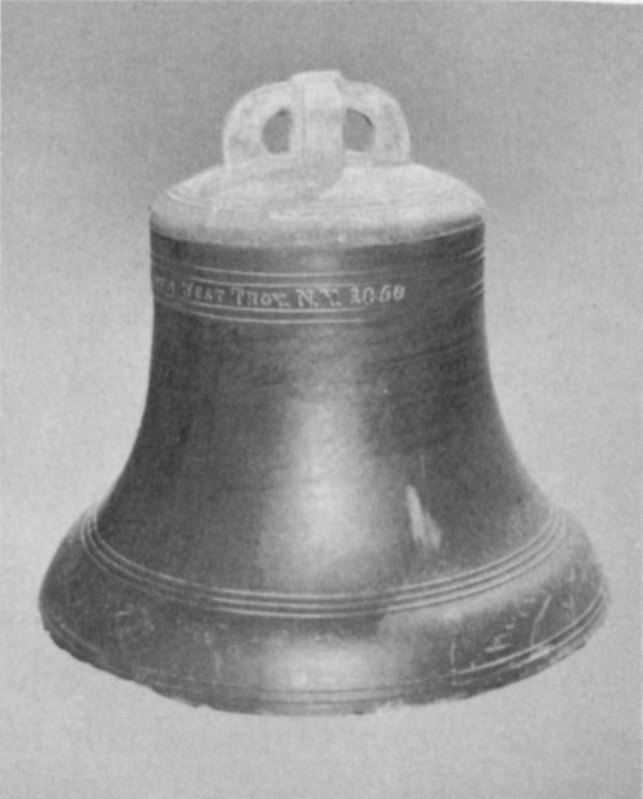
The bell as it appears today.
Once the pride of Dayton firemen, the large fire bell which today is housed in Carillon Park alongside the steam fire engine is almost a century old. It was cast in 1858 by the Meneely Bell Company, the same concern which several generations later produced the bells used in Deeds Carillon.
For more than a decade after its purchase, the $700 bell tolled out fire alarms from the tower of the firehouse at Fifth and Brown Streets. It was considered the loudest and finest fire bell in the Dayton area. During an extended tolling, however, the bell suddenly cracked. Although attempts were made to repair the fissure, the bell’s tonal qualities were lost and it was subsequently replaced.
In 1914, the bell seemed headed for the junkyard until a group of citizens learned of plans for its disposal. The city manager of that period was advised that a committee opposed to destruction of the bell would call on him to register their protest. When the committee arrived, however, the city manager showed them the bell ... which had been quickly converted into a giant flower urn at the Main and Monument Firehouse. “Gentlemen, there is your bell,” he said. “You can see that it is perfectly safe and sound.”
The committee’s fears were thus alleviated, although it is doubtful that they expected the bell to remain in that location for more than forty years. It was finally transferred to Carillon Park in 1955.
CARILLON PARK
DAYTON, OHIO
One of a series of Carillon Park booklets.
Price ten cents.
AS-8575
I15XX
PRINTED IN U.S.A.